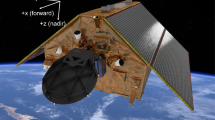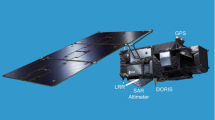Abstract
The Sentinel-6 mission aims to provide high-precision ocean altimetry measurements. Altimeter processing relies on highly accurate knowledge of satellite position and attitude. For precise orbit determination (POD), the Sentinel-6A spacecraft is equipped with a dual-constellation global navigation satellite system (GNSS) receiver and dual GNSS POD antennas. The satellite attitude is indispensable for connecting the satellite body reference frame and the inertial system. The actual satellite attitude is determined from the dual-antenna-based orbit differences and the antenna baseline information. We developed a yaw-attitude model for Sentinel-6A based on 75 days of data in 2021. Single-receiver ambiguity resolution is carried out to further explore the orbit determination accuracy. Different orbits, including the global positioning system (GPS)-only, Galileo-only, GPS/Galileo-combined orbits related to the GNSS POD antenna and orbit based on the data collected by the GNSS radio occultation (GNSS-RO) POD antenna (GNSS-RO orbit), are generated and their consistency is analyzed to investigate the impact of the attitude model and ambiguity resolution on POD. With the established model, the consistency between orbits determined using dual-antenna observations is improved by 41, 70 and 53% in along-track, cross-track and radial directions with respect to the nominal attitude. Compared with the GPS/Galileo-combined solution, the 3D RMS errors of the GPS-only and Galileo-only solutions are better than 4 and 3 mm, and a 12.6 mm RMS is obtained for the GNSS-RO orbit. The STD of satellite laser ranging (SLR) residuals for GPS/Galileo-combined solutions is improved from 14 mm with nominal attitude to 9 mm with the established attitude model. A 10 mm consistency of GNSS-RO, GPS-only and Galileo-only orbits with SLR observations is also achieved.











Similar content being viewed by others
Data availability
The Sentinel-6A GNSS observations were obtained from https://earthdata.nasa.gov. The CODE’s GNSS orbit, clock and observation-specific bias (OSB) products are available at ftp://aiub.unibe.ch/CODE_MGEX/CODE/. Sentinel-6A SLR data can be found at ftp://edc.dgfi.tum.de/pub/slr/data. The Sentinel-6A orbits and phase center variation corrections generated during the current study are available from the corresponding author on reasonable request.
References
Romero I (2020) RINEX—the receiver independent exchange format version 3.05. https://files.igs.org/pub/data/format/rinex305.pdf. Accessed 15 December 2021
Arnold D, Schaer S, Villiger A, Dach R, Jäggi A (2018) Undifferenced ambiguity resolution for GPS-based precise orbit determination of low Earth orbiters using the new CODE clock and phase bias products. In: Proceedings of the International GNSS Service Workshop 2018, Wuhan, China, 29 October–2 November 2018. http://www.bernese.unibe.ch/publist/2018/post/IGSWS2018_LEOAR.pdf. Accessed 15 December 2021
Auriol A, Tourain C (2010) DORIS system: the new age. Adv Space Res 46(12):1484–1496. https://doi.org/10.1016/j.asr.2010.05.015
Bar-Sever YE (1996) A new model for GPS yaw attitude. J Geod 70(11):714–723. https://doi.org/10.1007/BF00867149
Bertiger WI, Desai SD, Haines B, Harvey N, Moore AW, Owen S, Weiss JP (2010) Single receiver phase ambiguity resolution with GPS data. J Geod 84(5):327–337. https://doi.org/10.1007/s00190-010-0371-9
Bloßfeld M, Zeitlhöfler J, Rudenko S, Dettmering D (2020) Observation-based attitude realization for accurate Jason satellite orbits and its impact on geodetic and altimetry results. Remote Sens 12(4):682. https://doi.org/10.3390/rs12040682
Bock H, Jäggi A, Beutler G, Meyer U (2014) GOCE: precise orbit determination for the entire mission. J Geod 88(11):1047–1060. https://doi.org/10.1007/s00190-014-0742-8
Bruinsma S (2015) The DTM-2013 thermosphere model. J Space Weather Space Clim 5:A1. https://doi.org/10.1051/swsc/2015001
Cohen CE, Lightsey EG, Parkinson BW (1994) Space flight tests of attitude determination using GPS. Int J Satell Commun 12(5):427–433. https://doi.org/10.1002/sat.4600120504
Collins P, Bisnath S, Lahaye F, Héroux P (2010) Undifferenced GPS ambiguity resolution using the decoupled clock model and ambiguity datum fixing. J Inst Navigat 57(2):123–135. https://doi.org/10.1002/j.2161-4296.2010.tb01772.x
Cullen R (2021) Sentinel-6A POD context, JC-TN-ESA-0420, v1.4, 1 Feb. 2021
Desai SD (2002) Observing the pole tide with satellite altimetry. J Geophys Res 107:1–13. https://doi.org/10.1029/2001JC001224
Dilssner F, Springer T, Gienger G, Dow J (2011) The GLONASS-M satellite yaw-attitude model. Adv Space Res 47(1):160–171. https://doi.org/10.1016/j.asr.2010.09.007
Donlon CJ, Cullen R, Giulicchi L, Vuilleumier P, Francis CR, Kuschnerus M, Simpson W, Bouridah A, Caleno M, Bertoni R et al (2021) The Copernicus Sentinel-6 mission: enhanced continuity of satellite sea level measurements from space. Remote Sens Environ 258(112):395. https://doi.org/10.1016/j.rse.2021.112395
Ge M, Gendt G, Rothacher M, Shi C, Liu J (2008) Resolution of GPS carrier-phase ambiguities in precise point positioning (PPP) with daily observations. J Geod 82(7):389–399. https://doi.org/10.1007/s00190-007-0187-4
Geng J, Bock Y (2013) Triple-frequency GPS precise point positioning with rapid ambiguity resolution. J Geod 87(5):449–460. https://doi.org/10.1007/s00190-013-0619-2
Georgi G (2017) Attitude determination. In: Teunissen P, Montenbruck O (eds) Springer handbook of global navigation satellite systems. Springer, Berlin, pp 781–809. https://doi.org/10.1007/978-3-319-42928-1_17
Hauschild A, Mohr U, Markgraf M, Montenbruck O (2019) Flight results of GPS-based attitude determination for the microsatellite flying laptop. Navigation 66(2):277–287
Ho SP, Anthes RA, Ao CO, Healy SB, Horanyi A, Hunt D, Mannucci AJ, Pedatella N, Randel WJ, Simmons A, Steiner A, Xie F, Yue X, Zeng Z (2019) The COSMIC/FORMOSAT-3 radio occultation mission after 12years: accomplishments, remaining challenges, and potential impacts of COSMIC-2. Bull Am Meteorol Soc. https://doi.org/10.1175/BAMS-D-18-0290.1
Jäggi A, Dach R, Montenbruck O, Hugentobler U, Bock H, Beutler G (2009) Phase center modeling for LEO GPS receiver antennas and its impact on precise orbit determination. J Geod 83(12):1145–1162. https://doi.org/10.1007/s00190-009-0333-2
Jin B, Li Y, Jiang K, Li Z, Chen S (2021) GRACE-FO antenna phase center modeling and precise orbit determination with single receiver ambiguity resolution. Remote Sens 13:4204. https://doi.org/10.3390/rs13214204
Kang ZG, Tapley B, Chen JL, Ries J, Bettadpur S (2009) Geocenter variations derived from GPS tracking of the GRACE satellites. J Geod 83(10):895–901. https://doi.org/10.1007/00190-009-0307-4
Knight FL (1996) The space test program APEX mission–Flight results.In: AIAA/USU Conf Small Satell, Utah State University Logan, pp 1–15
Kornfeld RP, Arnold BW, Gross MA, Dahya NT, Klipstein WM, Gath PF, Bettadpur S (2019) GRACE-FO: the gravity recovery and climate experiment follow-on mission. J Spacecraft Rock 56(3):931–951. https://doi.org/10.2514/1.A34326
Kouba J (2008) A simplified yaw-attitude model for eclipsing GPS satellites. GPS Solut 13(1):1–12. https://doi.org/10.1007/s10291-008-0092-1
Kuang D, Desai S, Sibois A (2017) Observed features of GPS Block IIF satellite yaw maneuvers and corresponding modeling. GPS Solut 21:739–745. https://doi.org/10.1007/s10291-016-0562-9
Kursinski ER, Hajj GA, Schofield JT, Linfield RP, Hardy KR (1997) Observing earth’s atmosphere with radio occultation measurements using the global positioning system. J Geophys Res 102:23429–23465. https://doi.org/10.1029/97JD01569
Laurichesse D, Mercier F, Berthias J, Broca P, Cerri L (2009) Integer ambiguity resolution on undifferenced GPS phase measurements and its application to PPP and satellite precise orbit determination. Navigation 56(2):135–149. https://doi.org/10.1002/j.2161-4296.2009.tb01750.x
Liu J, Ge M (2003) PANDA software and its preliminary result of positioning and orbit determination. Wuhan Univ J Nat Sci 8:603–609. https://doi.org/10.1007/BF02899825
Liu M, Yuan Y, Ou J, Chai Y (2019) Research on attitude models and antenna phase center correction for Jason-3 satellite orbit determination. Sensors 19(10):2408. https://doi.org/10.3390/s19102408
Loyer S, Perosanz F, Mercier F, Capdeville H, Marty JC (2012) Zero difference GPS ambiguity resolution at CNES-CLS IGS analysis center. J Geod 86(11):991–1003. https://doi.org/10.1007/s00190-012-0559-2
Lyard F, Lefevre F, Letellier T, Francis O (2006) Modelling the global ocean tides: insights from FES2004. Ocean Dyn 56:394–415. https://doi.org/10.1007/s10236-006-0086-x
Montenbruck O, Schmid R, Mercier F, Steigenberger P, Noll C, Fatkulin R, Kogure S, Ganeshan AS (2015a) GNSS satellite geometry and attitude models. Adv Space Res 56(6):1015–1029. https://doi.org/10.1016/j.asr.2015.06.019
Montenbruck O, Steigenberger P, Hugentobler U (2015b) Enhanced solar radiation pressure modeling for Galileo satellites. J Geod 89:283–297. https://doi.org/10.1007/s00190-014-0774-0
Montenbruck O, Steigenberger P, Prange L, Deng Z, Zhao Q, Perosanz F, Romero I, Noll C, Stürze A, Weber G, Schmid R, MacLeod K, Schaer S (2017) The multi-GNSS experiment (MGEX) of the international GNSS service (IGS) – achievements. Prospect Challenges Adv Space Res 59(7):1671–1697. https://doi.org/10.1016/j.asr.2017.01.011
Montenbruck O, Hackel S, Jäggi A (2018) Precise orbit determination of the Sentinel-3A altimetry satellite using ambiguity-fixed GPS carrier phase observations. J Geod 92:711–726. https://doi.org/10.1007/s00190-017-1090-2
Montenbruck O, Hauschild A, Langley R, Siemes C (2019) CASSIOPE orbit and attitude determination using commercial off-the-shelf GPS receivers. GPS Solut 23:114. https://doi.org/10.1007/s10291-019-0907-2
Montenbruck O, Hackel S, Wermuth M, Zangerl F (2021) Sentinel-6A precise orbit determination using a combined GPS/Galileo receiver. J Geod 95:109. https://doi.org/10.1007/s00190-021-01563-z
Montenbruck O, Kunzi F, Hauschild A (2022) Performance assessment of GNSS-based real-time navigation for the Sentinel-6 spacecraft. GPS Solut 26:12. https://doi.org/10.1007/s10291-021-01198-9
Petit G, Luzum B (2010) IERS conventions. IERS Techn Note 36(1):210
Rebischung P, Schmid R (2016) IGS14/igs14.atx: a new framework for the IGS products. In: AGU Fall Meeting, San Francisco, CA
Roselló J, Silvestrin P, Weigand R, d’Addio S, Rodríuez AG, Risueño GL (2012) Next generation of ESA’s GNSS receivers for Earth observation satellites. In: 2012 6th ESA workshop on satellite navigation technologies (Navitec 2012) & European workshop on GNSS signals and signal processing. IEEE, pp 1–8. https://doi.org/10.1109/NAVITEC.2012.6423104
Schaer S, Villiger A, Arnold D, Dach R, Prange L, Jäggi A (2021) The CODE ambiguity-fixed clock and phase bias analysis products: generation, properties, and performance. J Geod 95(7):1–25. https://doi.org/10.1007/s00190-021-01521-9
Scharroo R, Bonekamp H, Ponsard C, Parisot F, von Engeln A, Tahtadjiev M, de Vriendt K, Montagner F (2016) Jason continuity of services: continuing the Jason altimeter data records as Copernicus Sentinel-6. Ocean Sci 12(2):471–479. https://doi.org/10.5194/os-12-471-2016
Shako R, Förste C, Abrikosov O, Bruinsma S, Marty J-C, Lemoine J-M, Flechtner F, Neumayer H, Dahle C (2014) EIGEN-6C: a high-resolution global gravity combination model including GOCE data. In: Flechtner F, Sneeuw N, Schuh W-D (eds) Observation of the system earth from space - CHAMP, GRACE, GOCE and future missions. Advanced Technologies in Earth Sciences. Springer, Berlin, pp 155–161. https://doi.org/10.1007/978-3-642-32135-1_20
Vaclavovic P, Dousa J (2016) G-Nut/Anubis: open-source tool for multi-GNSS data monitoring with a multipath detection for new signals, frequencies and constellations. In: AG 150 years: proceedings of the IAG scientific assembly in Postdam, 2013. Springer, Germany, pp 775–782. https://doi.org/10.1007/1345_2015_97
Wang C, Guo J, Zhao Q, Liu J (2018) Yaw attitude modeling for BeiDou I06 and BeiDou-3 satellites. GPS Solut 22:117. https://doi.org/10.1007/s10291-018-0783-1
Wang Y, Li M, Jiang K, Li W, Zhao Q, Peng H, Lin M (2022) Precise orbit determination of the Haiyang 2C altimetry satellite using attitude modeling. GPS Solut 26:35. https://doi.org/10.1007/s10291-021-01219-7
Wu SC, Yunck TP, Thornton CL (1991) Reduced-dynamic technique for precise orbit determination of low earth satellites. J Guid Control Dyn 14(1):24–30. https://doi.org/10.2514/3.20600
Wu JT, Wu SC, Hajj G, Bertiger WI, Lichten SM (1993) Effects of antenna orientation on GPS carrier phase. Manuscr Geod 18(2):91–98
Xia Y, Liu X, Guo J, Yang Z, Qi L, Ji B, Chang X (2021) On GPS data quality of GRACE-FO and GRACE satellites: Effects of phase center variation and satellite attitude on precise orbit determination. Acta Geod Et Geophys 56:93–111. https://doi.org/10.1007/s40328-020-00324-2
Zhao Q, Guo J, Wang C, Liu Y, Xu X, Yang C, Li J (2022) Precise orbit determination for BDS satellites. Satell Navig 3:2. https://doi.org/10.1186/s43020-021-00062-y
Acknowledgements
The authors acknowledge the European Space Agency (ESA) for the provision of Sentinel-6A onboard data. The authors acknowledge the International GNSS service (IGS) Multi-GNSS Experiment (MGEX) and the Center for Orbit Determination in Europe (CODE) for providing the GNSS products. The authors are also grateful to the EUROLAS Data Center (EDC) for providing the SLR data. This work was supported by the National Natural Science Foundation of China (Grant numbers 41974041, 42074032, 41931075 and 42030109).
Funding
National Natural Science Foundation of China, 41974041, Biao Jin, 42074032, Min Li, 41931075, Min Li, 42030109, Min Li.
Author information
Authors and Affiliations
Contributions
All authors contributed to the study conception and design. Material preparation, data collection and analysis were performed by BJ, SC, ML and FY. The first draft of the manuscript was written by BJ and LZ. All authors commented on previous versions of the manuscript. All authors read and approved the final manuscript.
Corresponding author
Ethics declarations
Conflict of interests
The authors have no competing interests to declare that are relevant to the content of this article.
Additional information
Publisher's Note
Springer Nature remains neutral with regard to jurisdictional claims in published maps and institutional affiliations.
Rights and permissions
Springer Nature or its licensor holds exclusive rights to this article under a publishing agreement with the author(s) or other rightsholder(s); author self-archiving of the accepted manuscript version of this article is solely governed by the terms of such publishing agreement and applicable law.
About this article
Cite this article
Jin, B., Chen, S., Li, M. et al. Sentinel-6A attitude modeling with dual GNSS antennas and its impact on precise orbit determination. GPS Solut 27, 7 (2023). https://doi.org/10.1007/s10291-022-01346-9
Received:
Accepted:
Published:
DOI: https://doi.org/10.1007/s10291-022-01346-9




